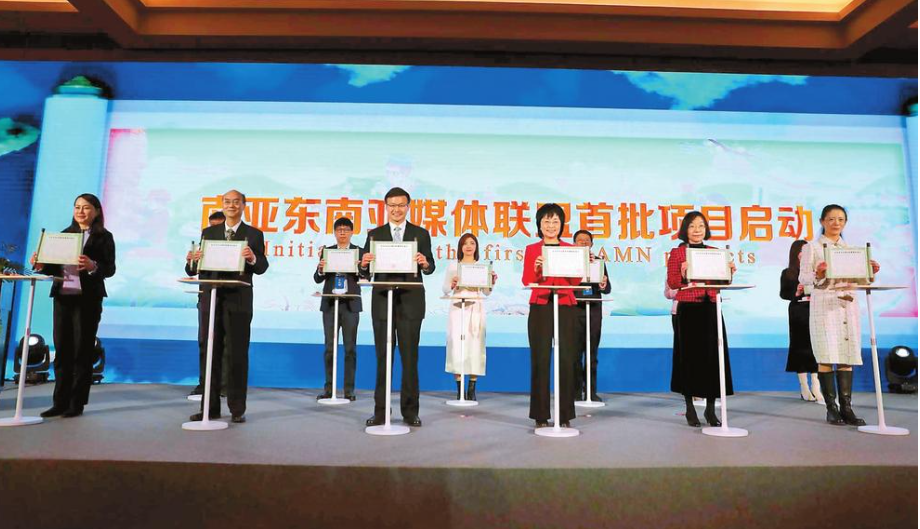Media network founded, kicking off 21 projects
The South and Southeast Asian Media Network (SSAMN) was founded in Beijing on January 31.
Yunnan International Communication Center for South and Southeast Asia and China Daily Asia Pacific lead the establishment of the network, and have invited media organizations, reporters' associations and news agencies from countries in or related to South and Southeast Asia to join.
The SSAMN aims to give full play to Yunnan's advantages in opening-up to South Asia and Southeast Asia, deepen the media cooperation between China (Yunnan) and countries in these regions, and promote people-to-people connections and regional socioeconomic development.
Cooperation
At the founding ceremony, the word “cooperation” was frequently mentioned.
Makhdoom Babar, president and editor-in-chief of the Pakistani newspaper Daily Mail, said:
"The SSAMN will greatly promote Pakistan-China cultural exchanges, and media cooperation has increased folk friendship in the two countries."
Vansay Tavinyan, deputy head of the Publicity and Training Board of the Lao Party's Central Committee and editor-in-chief of Pasaxon Newspaper, said:
Since 2014, Pasaxon Newspaper has cooperated closely with Yunnan Daily Press Group, telling international audience the Laos-China exchanges and cooperation and sharing information on China’s Yunnan province. The media network will broaden exchanges and cooperation among regional countries.
Watcharin Setakudan, director of international news department of MCOT Thailand, said:
The MCOT Thailand has cooperated with Yunnan International Communication Center by opening the “China Yunnan” columns on all-media platforms. This has won praises.
In 2024, the two sides will jointly launch the See China Together project for international communication, in a bid to enhance Thai people’s understanding to Yunnan and deepen the family-like Thai-Chinese ties.

Projects
At the event, the SSAMN’s first 21 projects were launched, with the SSAMN Action Plan 2024 released.
In 2024, Yunnan International Communication Center for South and Southeast Asia (YICC) will cooperate with China Daily, China International Communication Group, peer international communication centers in other Chinese provinces and related businesses, as well as with the mainstream media in Thailand, Cambodia, Laos, Nepal and others. The cooperation will involve news inter-posting, video making, cultural exchanges, creative products, cultural tourism and others.
In September, 2023, the YICC and Myanmar VIDYA Media Co., Ltd. signed a cooperation project on international communication -- "paukphaw friends visiting each other in youthful spirits". The project tells stories and brotherly friendship of young people in China and Myanmar.
"I hope to take the SSAMN establishment as an opportunity, having closer cooperation with the YICC for more mutual trust and common development," said general manager of Myanmar VIDYA .
In 2024, the YICC and the Nepal-based Jana Aastha National Weekly will jointly launch the project of shooting the "guardian of history" micro-documentary, cooperating with the South Asia Network TV Media Group (SATV).
"I hope media in the network will tell the story of promoting common development and mutual learning," said Kishor Shrestha, editor-in-chief of the Jana Aastha National Weekly.
Cambodia's Koh Santepheap Daily has cooperated constructively with Yunnan Daily Press Group and the YICC, yielding fruitful results.
"I firmly believe the SSAMN will be a new approach to further friendly cooperation between China and south and southeast Asian countries," said Thong Sovan Raingsey, secretary-general of the Club of Cambodian Journalists and general manager of Koh Santepheap Daily.
On the same day, the S&SE Asian journalists' club was unveiled.
And the YICC’s sub-centers in Kunming, Chuxiong, Wenshan and Lijiang were established.
We expects the SSAMN to be a liaison for mutual trust, a driver for win-win cooperation and a guardian of Asian civilization, contributing to the next golden decade of Belt and Road cooperation.
Editing by Zhu Dongran; translating by Wang Shixue; proofreading by Wang Huan and Zhang Ruogu; Photos by Yunnan Daily








